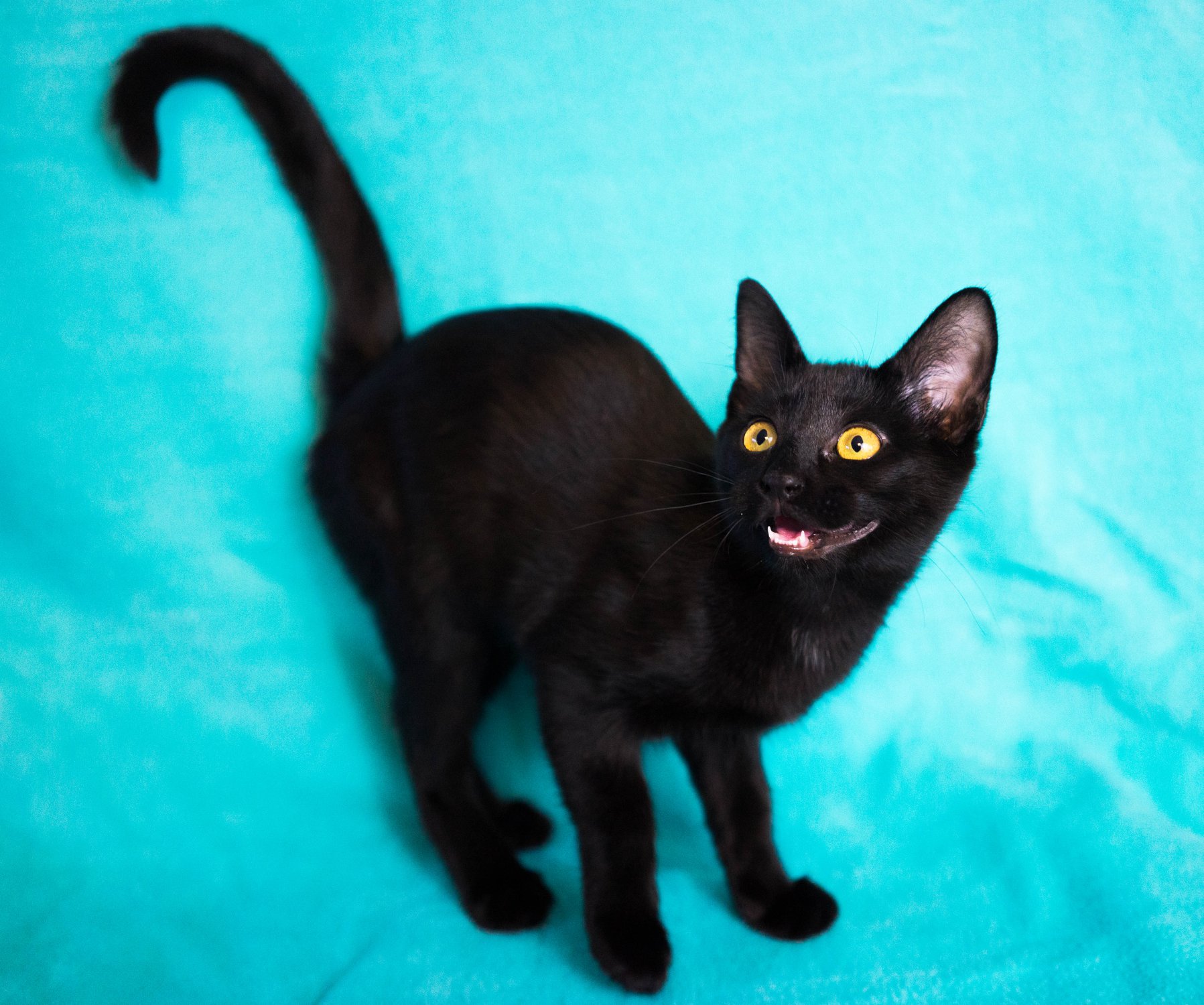
Speaking Cat: Feline Body Language and Communication
Body language and communication…big topics and a very important ones to cover. Being able to read your cat is an important skill, and I’m surprised by just how often I notice people aren’t aware of what even simple cues are saying! Today we’re going to try putting an end to that, I'm going to teach you to speak (or, read?) cat! Since cats can’t speak like we do, this can lead to a lot of misunderstandings, mark my words though, they are constantly communicating with us! Their body language, their vocalizations, and even through subtleties we cannot pick up through no fault of our own. I’m going to go super in-depth here, explaining their senses as we go so we have a true understanding of how the cat world works. Let's go!
It is important to look at the cats whole body when trying to determine its emotional state as cats give clear indications of how they are feeling, but these clues usually start out subtle and escalate. We’re going to go body part by body part...but just looking at the eyes, for example, may not be enough. Dilated pupils alone will not tell you how the cat is feeling, you may need to know what the tail is doing. Maybe it’s just a dark room! It’s also worth noting that in some cats these get trickier. It’s harder to read the general body carriage or tenseness of a cat that’s got a very thick, fluffy coat. It may be hard to tell if a Scottish Fold’s ears are upright or flattened. What if you have a cat with retinal detachment or double enucleation? No eyes or constant dilation, that can’t be read at all! So, the signs may be a bit different and this furthers the point that everythintg must be taken into account. With that in mind, let’s continue!
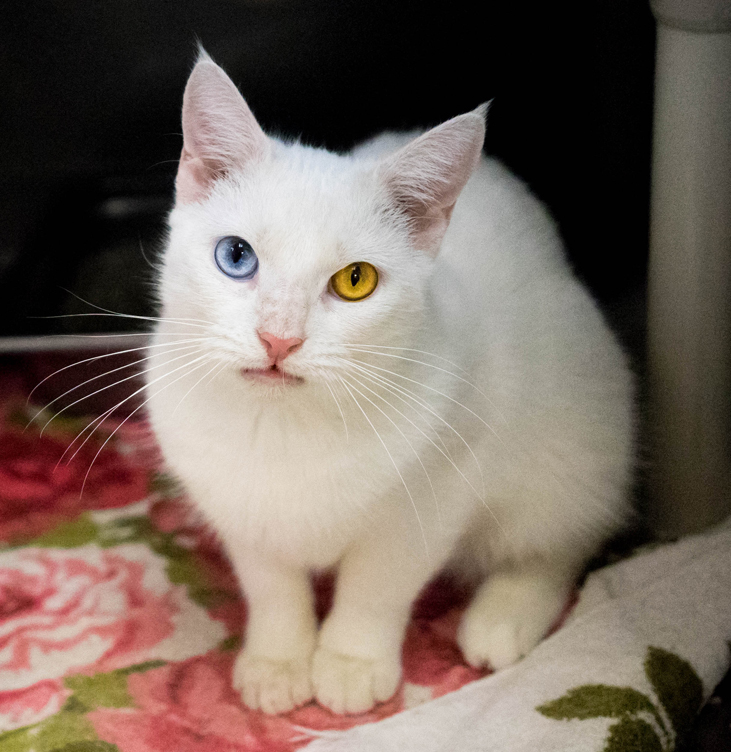
We’ve only just begun, but how would you say this cat feels? This cat is a bit nervous. The clues: it’s lowering its body, its weight towards its hind end. Its also interested; its ears turned forward, whiskers not quite in a neutral position. Its eyes are just a bit constricted over neutral dilation. If I extended a treat or finger to greet and let the cat sniff, it would likely be friendly.
The Nose/Scent:
- 1. Kittens can smell from the moment they’re born, it’s their most developed sense next to touch, the only two they have for the first week of life. It is how they are able to find their mother’s teat, detecting the pheromones emitted from the mammary glands.
- 2. Cats have an astounding 200 million scent receptors.
- 3. Cats have scent glands in their cheeks, chin, ears, between their toes, around the tail, mammary glands, and anal glands. All of these serve different purposes. The cheeks contain the F3 facial pheromone which is a calming pheromone associated with contentment or ownership that cats use to feel confident in their territory. This is the pheromone used in most diffusers. The mammary glands contain the Cat Appeasing Pheromone, which is also used in some diffusers - formerly Feliway Multi-Cat, and now Optimum. The paws contain the Interdigital Semiochemical, this is also a calming pheromone used for territorial marking. This is used in products such as Feliscratch. The other pheromones produced by other parts of the body don’t seem to have fancy names that I’ve been able to find, but all have their purpose! The anal glands deposit pheromones in the urine or feces to transmit information. This can be to mark territory, to display reproductive status, and more!
- 4. Due to the pheromones deposited in the urine and feces, the cats vomeronasal organ which we’ve discussed in a previous post they are able to tell such information simply from smelling it – they can tell what sex the cat is, if they’re in heat or not, if they’re aggressive or not, if they're unwell, and more! Pheromones are crazy things!
- 5. A cat presenting its nose for a bump or sniff to you, another cat (or that cats rump!) is a friendly greeting. The nose is pretty much always a hello!
- 6. Rubbing deposits pheromones, transferring scents to make the environment or item they’re rubbing on more familiar and comfortable. This can be to create a familial scent in a multi-cat home or cat colony, to secure their territory from threats ("This is mine, keep out!"), to display that they’re ready to mate, et cetera. Of course, affection is a big part of it too – but that’s also communication! I’ve seen it hypothesized that even the different affectionate rubs can mean different things, but haven’t seen any validation for it. Such as, a cheek rub is more of a “I own this and I love it” – while a flank rub is more of a “You are a part of my colony, you provide for me, and I respect you.” – One carrying more of an equal tone than the other. I don’t know that that holds much of any water, but I’ve found it interesting!
- 7. I noted above that cats use scent to create a familial scent in multi-cat homes or colonies. You may think, "What’s that about?" Scent really is how cats know family, it’s not about looks or memory. A communal scent is developed and the new cat is accepted in. If that scent changes due to illness or leaving to a place that is unfamiliar, sometimes that cat can be rejected, even brutally attacked as they’re seen as an intruder. Scent is absolutely vital in the cat world!
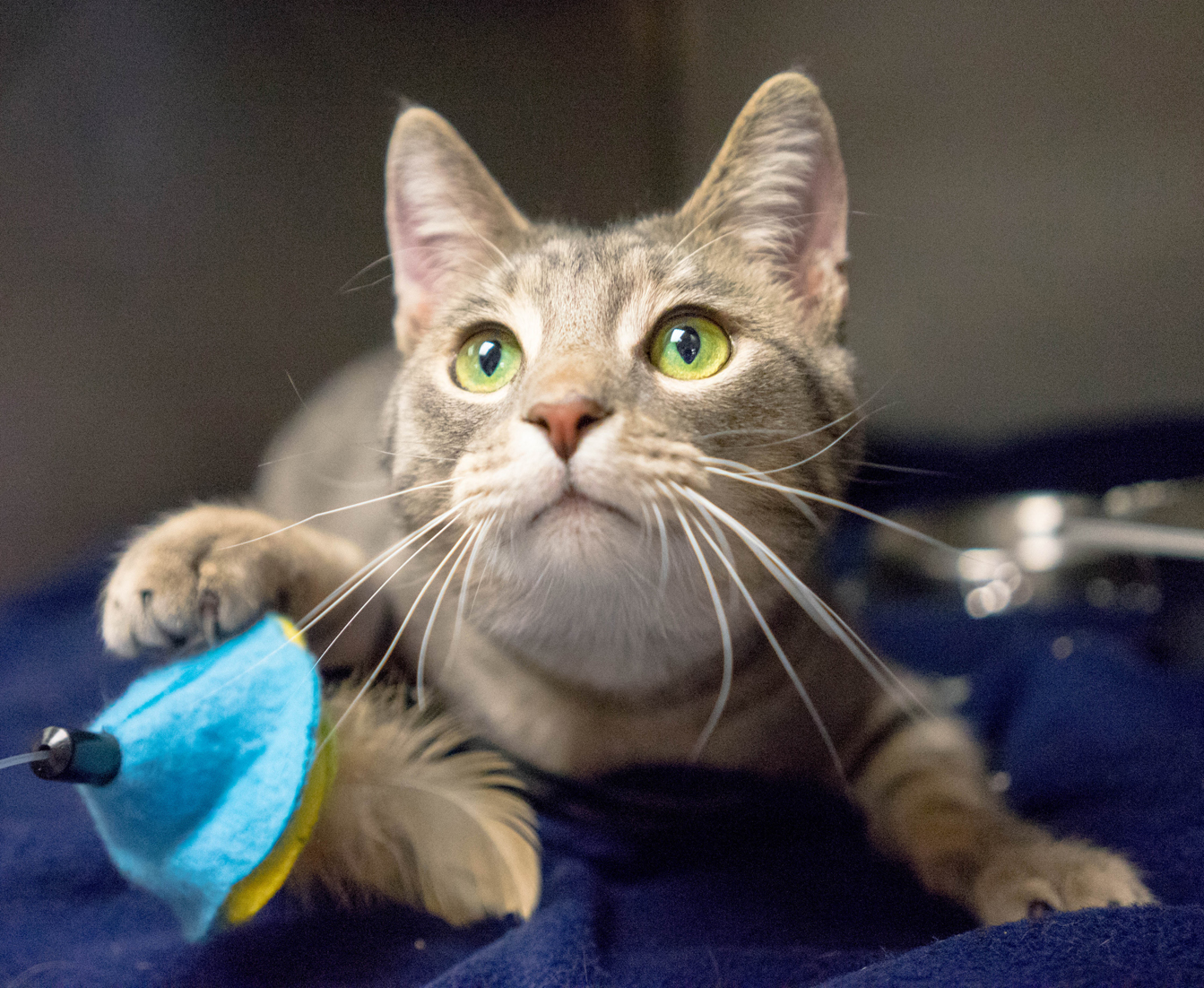
How does this cat feel? She’s intently focused and playful! Her ears are likely swiveling from side to side, scanning for noises. Her whiskers are turned forward, her eyes are neutral dilation, but wide. Her ears are upright and forward facing. Her body weight is forward. She’s happy, but wound up!
The Whiskers:
- 1. A cats whiskers aren’t too different than their regular hair, but they are coarser and rooted much deeper. They are located on the cheeks, chin, eyes, ears, and forelegs.
- 2. Whiskers act almost like antennae in insects, guiding the cat and providing more input about the world around them. The whiskers themselves do not have feeling, but are connected to many nerve endings in the hair follicle where they transmit the information.
- 3. The information whiskers provide is helpful as cats have somewhat poor vision. They have a special form of nearsightedness, seeing best at a moderate distance, not right in front of their faces...but not very far away either. Their vision is about 10x weaker than ours, so the information their whiskers gives them, paired with their impeccable motion sight which is superior to ours, is what makes them such great predators.
- 4. Their whiskers are so sensitive they can sense changes in air current, detect the size, shape, speed of objects and prey. They act as radar, being able to pick up the movement of air bouncing off of objects around them and detecting obstacles. They’re also protection, telling the cat when a threat is coming and triggering the instinct to flinch when it feels something approaching its eyes, or being able to detect whether they’re going to fit in a small space, as whiskers are proportionate to the size of the cat…as long as they’re not obese! The whiskers on the legs allow cats to detect the movement of downed prey, so they can be sure whether they’ve successfully made a kill or not, due to their poor close-up vision.
- 5. Whiskers are part of a cat’s proprioceptive system. Without whiskers, a cats balance is all out of whack and they can't exactly tell where their body is! This is why you’re instructed to never cut a cat’s whiskers. It might disorient them and make them very uncomfortable, maybe even cause them to get injured!
- 6. Cats can experience what is called whisker fatigue, a condition that can be frustrating or even downright painful for them. This is often caused by us feeding them from small bowls and it’s often why we complain about them begging for food when there’s still plenty in the bottom of those bowls! Their whiskers are attached to so many nerve endings and so many muscles, that constantly having them brush up against the sides of a bowl can be really agitating. I always recommend feeding them from saucers and letting them drink from fountains to avoid this!
Now for whisker communication:
- 1. Whiskers will point slightly downwards and relax to the sides when a cat is calm, relaxed, or affectionate. This is the “neutral” position.
- 2. They will point forward and become somewhat erect/fanned when the cat is feeling confident, is interested in something or is playful or hunting.
- 3. A cat that is defensively aggressive or fearful will pull its whiskers back towards its body, flattening them. The further back they are, the more fearful and defensive they are.
- 4. An offensively aggressive cat will have forward facing, pursed, tense whiskers – likely accompanied by threatening vocalizations.
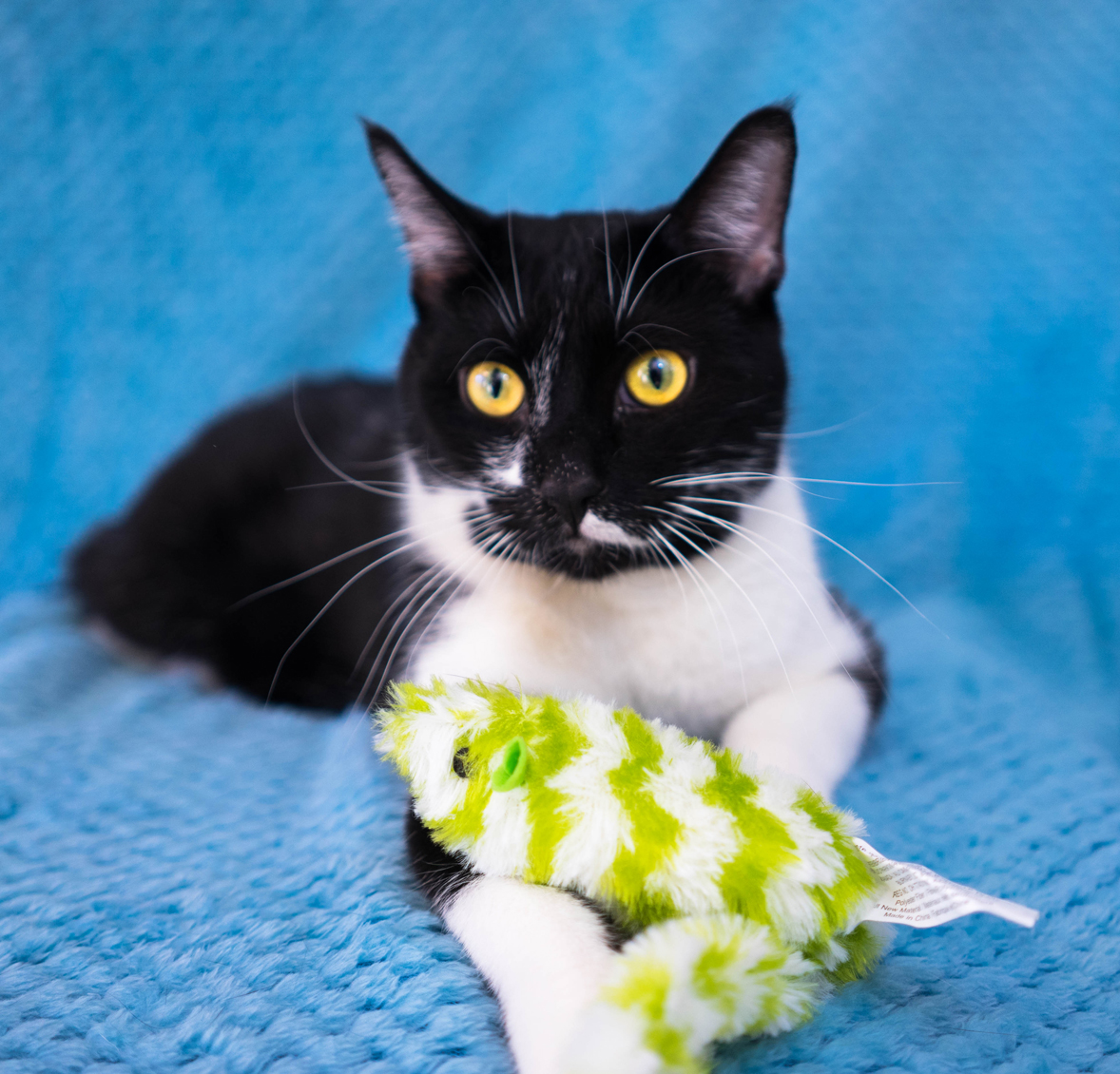
What about Sloan here? I’d say he’s pretty neutral! His body weight is a little forward so he is interested. His eyes are neutral in dilation, but wide. His ears are hanging a bit lower and slanted to the side in a more neutral position. His whiskers aren’t turned forward. He’s mostly just chilling, but intent on what I’m doing with this weird camera thing in my hands!
The eyes/Vision:
- 1. Kittens open their eyes between 7-10 days of age, their vision fully develops by 2 weeks of age.
- 2. A cat’s vision is 10x weaker than ours – although it may be superior at night and for movement. Cats have wider peripheral vision at 200 degrees, can see in the ultraviolet range (however, not to the degree that some other species do, like birds), they have a larger tapetum, and they have more rod cells than we do but are severely lacking in cones so they see very poorly in the daytime and lack much color vision.
- 3. Cats see in blue, gray, and green. Spectrums of red do not exist for them. They can see no further than 20ft in front of them (compared to a human’s 200ft) and have very poor vision for things directly in front of them – they do best with objects a foot or so away!
Communication:
- 1. Direct eye contact and staring are threatening gestures or very sincere signs of trust. If an unfamiliar cat is maintaining eye contact with you it might be time to back away! If your cat rolls over showing its tummy and stares into your eyes, however, you know you’re really loved. Never maintain eye contact with a cat for an extended period of time. If you make it, slow blink and then look off to the side. That’s a non-threatening, calming gesture that shows you’re not a threat.
- 2. Soft, half open eyes are a symbol of relaxation and trust. A cat that is threatened by you will not close their eyes! A cat with “soft” eyes is happy, content, affectionate. Try to have soft eyes when you interact with cats.
- 3. Wide eyes, constricted pupils = Interested, playful, hunting.
- 4. Wide eyes, dilated pupils = Terrified, potentially defensively aggressive.
- 5. Dilated pupils = Taking more information in about their environment, either because it’s dark, because they’re scared, anxious, threatened, or vulnerable in some way (In pain, ill) Potentially aggression, fear escalated to defensive aggression.
- 6. Constricted pupils = Confident, interested, focused, sunny area. Potentially aggression, focused on a threat, offensive aggresion.
- 7. Relaxed pupils – sufficient lighting, relaxed, affectionate.
- 8. Closed eyes, squinting, blinking: Closed eyes and blinking are good signs, typically indicating a happy and content or affectionate cat, but could be signs of discomfort depending on what the rest of the body is telling you. Squinting, however, might be a cause for concern. The cat may be unwell, uncomfortable, or in pain.
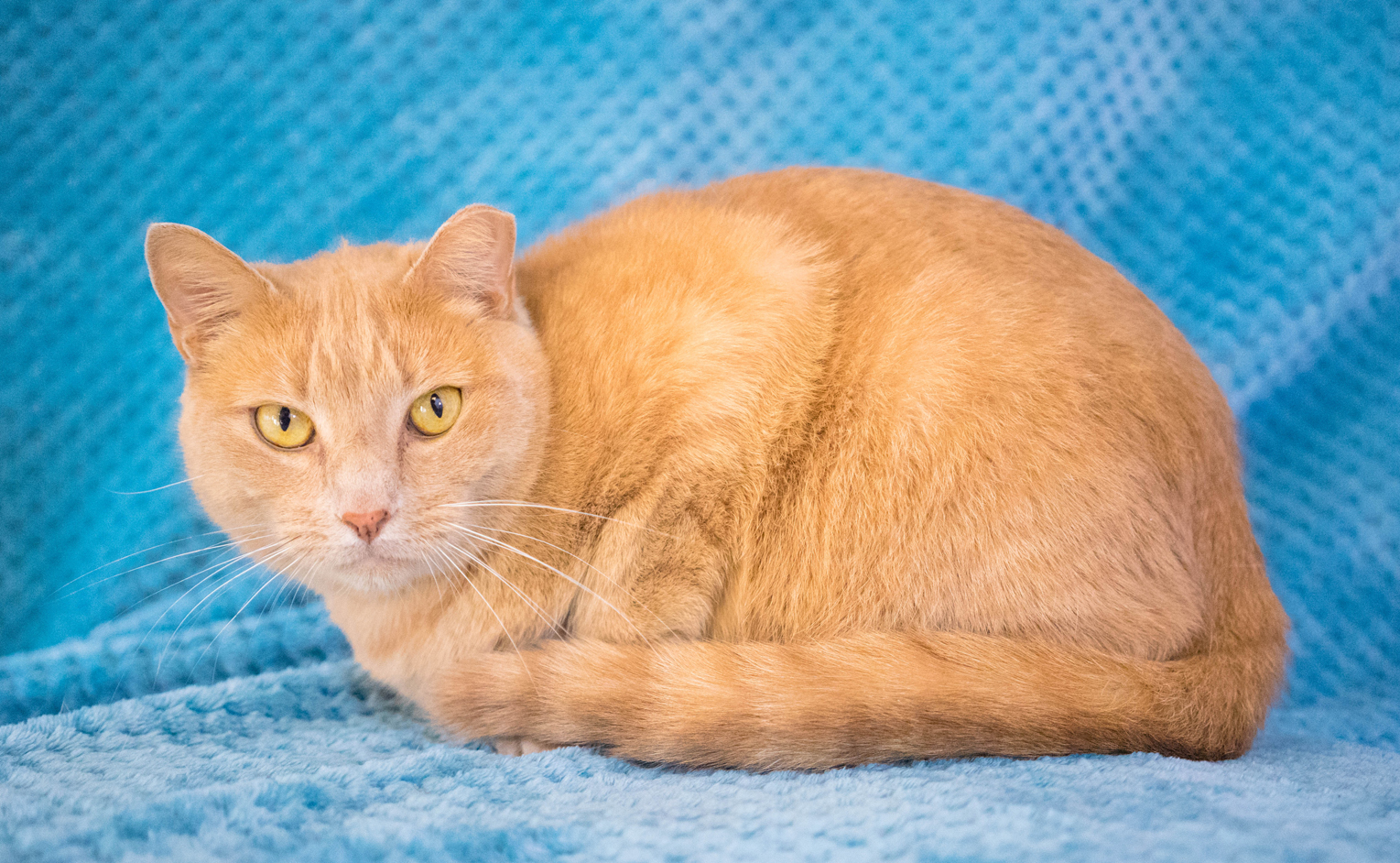
How about Fenneken? Fenneken is nervous, but not terribly so. He’s tense and making himself small. His tail is wrapped around his body, he’s hunched down low and tight, his weight is towards his hind with his head pulled back ever so slightly, but he’s interested in me. His ears are forward and upright, his eyes are neutral, his whiskers are fanned. He’d likely approach me if I provided something interesting, but he’s not too sure about this situation.
The Ears/Hearing:
- 1. The cats ears contain/are connected to 32 muscles and can move independently. They cam rotate up to 180 degrees, working like little satellites and tracking sounds independently.
- 2. Cats can tell the direction and locations of sound by differentiating the distance and time it takes to arrive at both ears! A sound that came from 3 feet away, they can pinpoint within three inches!
- 3. They can hear 4-5x the distance that we can.
- 4. The can hear frequencies one octave higher than dogs.
Communication:
- 1. When content or relaxed, a cats ears will be facing forward, upright, and tilted slightly sideways. A natural position, they simply "belong" here, not doing anything special.
- 2. A cat that is interested in something or playful will have tense, forward facing ears that are pricked upwards, likely swiveling to listen intently.
- 3. An unsure or uncomfortable cat will have what’s called airplane ears. They’re not completely flattened, they’re just flattening. This cat likely isn’t a threat, but they may be fearful and they may escalate to threat. They may just be taking information in for a moment – but it’s important to distinguish between airplane ears and the others.
- 4. A terrified cat will have flattened ears – they will be pulled backwards and flattened to the skull, making them as small as possible. This cat is terribly scared, it might soil itself, try to climb walls, potentially experience defensive aggression. It’s time to back away and let it decompress.
- 5. A confident, aggressive cat, or offensively aggressive cat will have its ears flattened but facing out, making them appear larger. These cats are likely to aggress, so it’s time to back away!
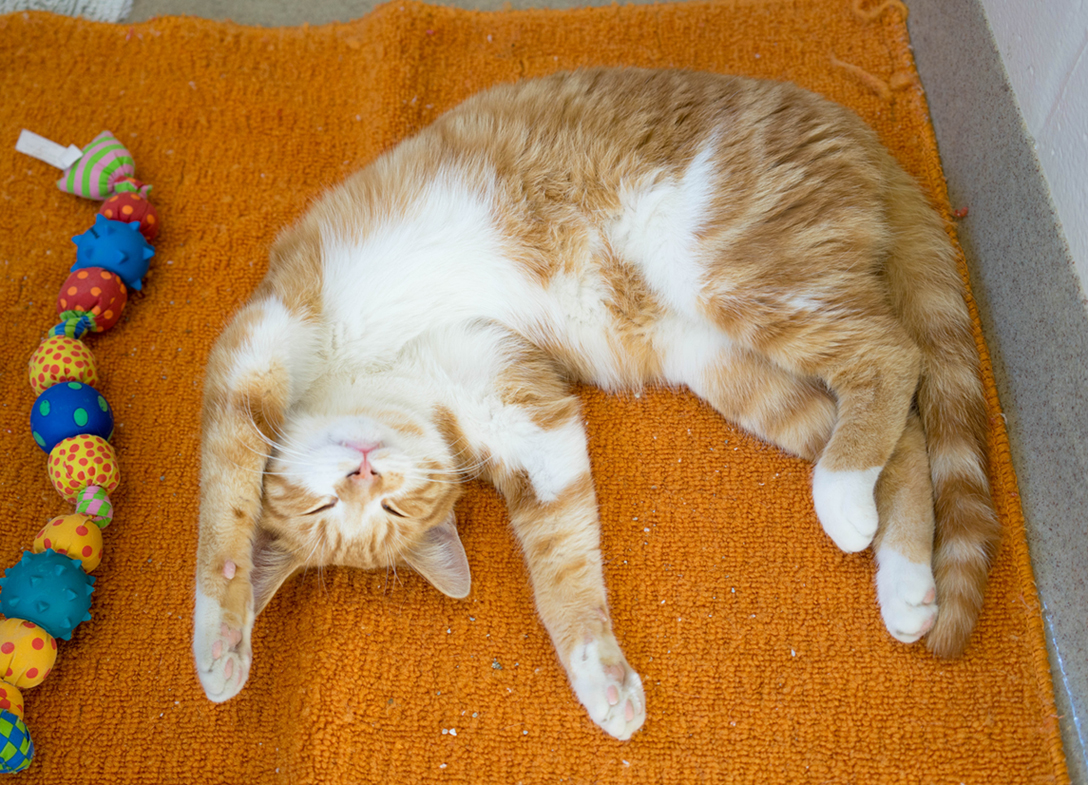
Dominick? This guy is so relaxed and happy! You can’t find a more neutral, friendly, and trusting cat!
The Whole Head:
- 1. A cat stretching its head forward is often friendly or interested, this is likely an invitation to interact. It may also be playful or focused. (Could also be offensive aggression, ready to lunge! Take whole cat into account!)
- 2. A neutral head posture is, well, neutral. It is relaxed, not leaning forward or backwards…just doing their thing!
- 3. A lowered head is a sign of fear, submission, or potentially defensive aggression. If their chin is pulled in and they are avoiding eye contact, they are distinctly saying they do not want to interact.
- 4. Of course bunts, rubs, and nose bumps, are all friendly and affectionate gestures or greetings.
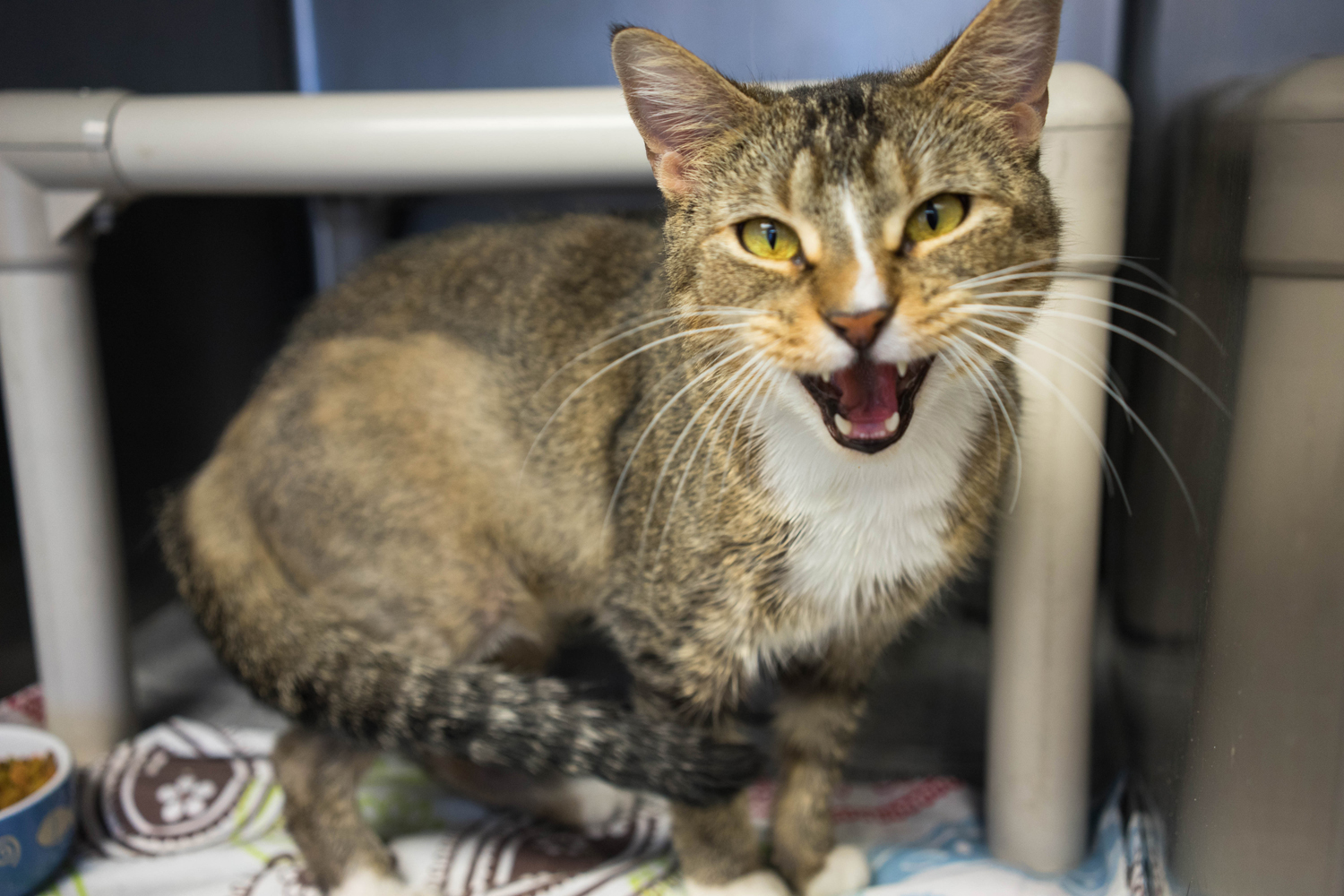
What about her?! Is she aggressive or happy? It's just a meow! Slanty eyes, upright and forward ears, fanned whiskers, – she’s alright!
Vocalization:
- 1. Feline vocal communication is actually very complex. We have identified and written about 21 distinct feline vocalizations, but there are most certainly more!
- 2. The Meow: We all know this one, but did you know it’s only for human communication? A feral cat will not meow. Cats meow at us to get what things from us - they really are manipulating us, mimmicking the young we care for!
- 3. The Mew: This is the kitten cry, distinct from the meow due to its pitch. This is used to communicate with their mother cat, but adults can use it too. Typically, there is an actual social structure to it – kittens will stop using it when their littermates are present at about 4 weeks of age, choosing to meow instead. (In my anthropomorphic mind, it’s like they’re embarrassed! “I’m grown now! Don’t pick on me!”) They typically will completely stop at 5 months of age. Adults doing it to humans is likely just another tactic they’ve learned works!
- 4. The Purr: Assists in locating the teat for nursing, is self-soothing, promotes healing, and appeasement. It is a low, vibratory sound that cats use when they are happy, content, stressed, scared, and even when injured and in pain. As mentioned before, there are purr frequencies that can improve bone density and promote healing!
- 5. Chirps and Trills: Mother cats often use these to call kittens to attention - "come to me", "follow", "here", etc. It is also often a sign of excitement and happiness. Kittens respond to the chirps of their mother, and do not to other mother cats. These are kind of like crosses between purrs and meows.
- 6. Chattering or The Ekekek: Predatory excitement (Or frustration, we’re not so sure!) When your cat is looking out the window and sees something it recognizes as prey and becomes riveted, it might make this sound. Chatter is a quiet stuttering or clicking sound – “ekekekek!” the internet has dubbed it. Sometimes it’s nearly silent, their jaw simply jutting.
- 7. The Yowl and Howl: This is a distress call. You may hear howling or yowling when your cat isn’t feeling well, when in a fight or frightening situation, or late at night when everyone else has gone to bed and it’s bored. The howl is distinguished from the yowl simply by being shorter in duration.
- 8. The Growl: This is a long, low-pitched vibratory sound that cats use as a warning. This sound is to scare off opponents or express danger or distress. Often in combination with howls, moans, yowls, and hisses.
- 9. The Moan: A lower pitched, longer meow that is often used when in distress or when soliciting something.
- 10. The Caterwaul: Somewhat similar to a howl or yowl, this is a cats mating call. Females caterwaul when in heat to attract a male, and males caterwaul when a female in heat is nearby. Caterwauls can also signify pain and distress.
- 11. The Hiss and Spit: Threatening gestures, open mouthed noises. These can be used offensively and defensively. The hiss is a sharp exhalation that can be drawn out, whereas spitting is a very sharp, shorter, more intense version of this noise. When a cat makes these noises, do not proceed.
- 12. The Shriek: A sharp, brief noise signifying pain or fear. Often when cats or fighting or, say, you’ve stepped on a paw or tail by accident!
- 13. The Snarl: An open mouthed growl, louder.
- 14. The Tweedle and Tweet: These are my favorite! If not just for the names! Well..and the ekekek! The tweedle is like a trill, but longer and with voice modulation. It’s prolonged, almost like they’re talking or singing. Those cats who walk around “brrllRrlrRRp!” all over the place! The best. Ah! The tweet is a really short, squeaky chirp, often in a series. It’s claimed they do these when they want something...I see them as happy sounds though, because if not, my Bogart wants something 24/7! He tweedles and tweets the entire time he plays every night, and walks around the house chirping and trilling, using them to respond to our speech even! It's a beautiful little symphony.
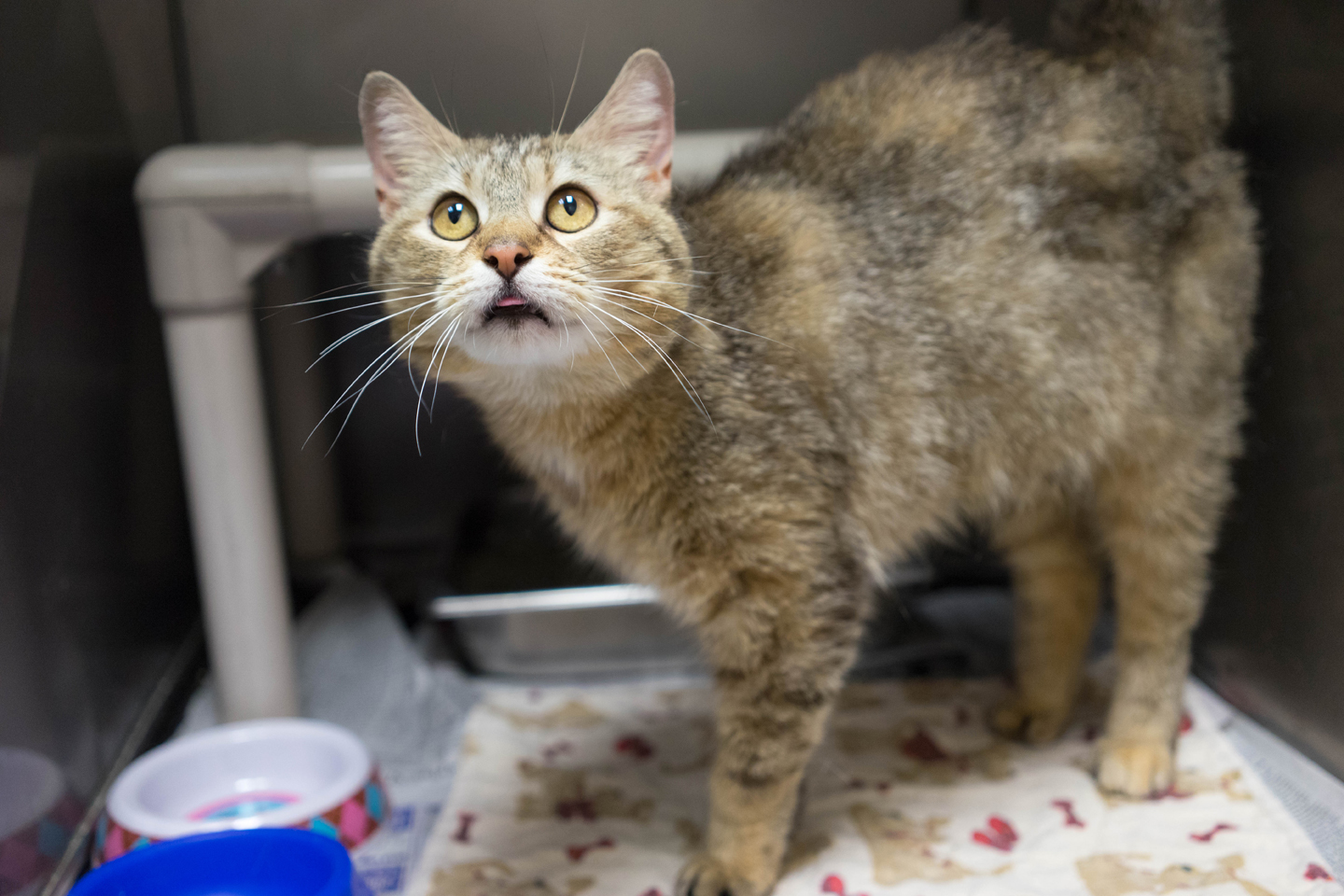
What about this girl? Excited, interested, but nervous. She was licking her lips, her front end was lower than her back end, settling to crouch a bit. Her eyes are wide and almost settling to a whale eye, ears turned sideways, but upright, whiskers turned back. She’s scared, but friendly.
The Paws:
- 1. Kneading can be a sign of happiness, affection, stress, or pain. Look at the whole picture for this one!
- 2. A cat that reaches its paw out to you might be begging for something. Maybe it wants affection or a treat?
- 3. A cat that taps you with its paw may be doing just the same, or may be soliciting play.
- 4. Swatting may be a warning, outright aggression, or play solicitation. The severity of it may be an indicator, but some also have poor inhibition, so body language would be your cue.
- 5. A raised paw can be a warning of an incoming attack or a sign of cautious interest. The cat may see something new in its environment and isn’t sure what to make of it or if it’s a threat, they have their paw at the ready to strike if there are any sudden movements.
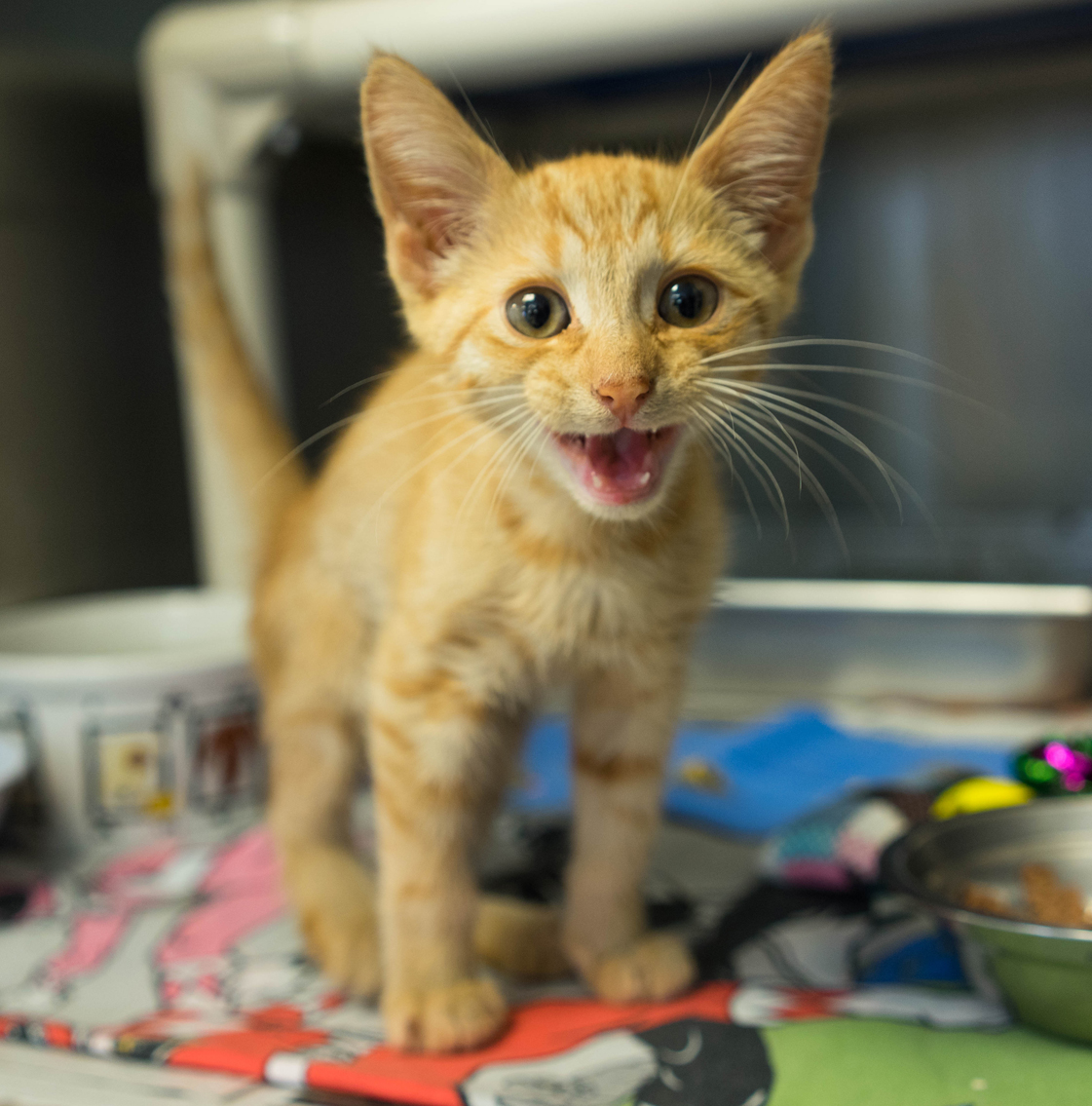
This guy? The epitome of confidence!
The Tail:
- 1. A tail that upright means a cat is happy, confident, friendly. The “question mark” or “hook” tail is the most desireable tail, that relaxed tip being an invitation to say hello!
- 2. A half-mast, neutral tail: The cat might be relaxed, curious, interested in something.
- 3. A tail lowered to the ground: The cat is scared, in pain or unwell.
- 4. A tail wrapped around the body or tucked under the cat: Terrified, trying to make itself small. Defensive, potentially in pain or unwell.
- 5. Piloerect or “puffy” tail: Threatened, scared, potentially aggressive, excited, spooked, playful. Piloerection is just a response to stimulation. Take the whole cat into account.
- 6. A cat that wraps its tail around you or another animal: Consider this a kitty hug! It’s a sign of affection.
- 7. A thrashing tail: This is a sign of agitation, overstimulation, or excitement. The entire tail is moving from side to side quickly and forcefully. Give this cat space to avoid further escalation. Sometimes they will do this when very focused on something, or when playing. If this happens when you’re petting a cat, stop immediately.
- 8. A thumping tail: A tail thats tip is thumping forcefully is a sign of agitation or excitement. This is a warning. “I’m getting overstimulated, please stop.” It will usually turn to thrashing then escalate to an attack. If they’re playing or watching something interesting, it may turn into a pounce.
- 9. A twitching tail: A tail with a twitching tip means the cat is interested in something, playful, or mildly irritated. This cat has seen something that its very interested in and would like to investigate further or interact with. This can also be the first sign of aggression, for example if another cat has just entered the cats territory, this could progress into a lashing tail and an aggressive attack. Not quite thumping, not quire quivering – cats are so subtle!
- 10. A quivering tail: A tail bolt upright and rapidly trembling from the base is most frequently seen as a part of spraying behavior, but when seen without the other cues that go along with that behavior, it is a sign of excitement! Oftentimes cats will have quivering tails when they greet their guardians, when being pet, or before being fed!
- 11. A swishing tail: When the whole tail is slowly and gently moving from side to side, this usually means the cat is alert, curious. and interested in his environment. This cat may be playful, focused, ready to pounce!
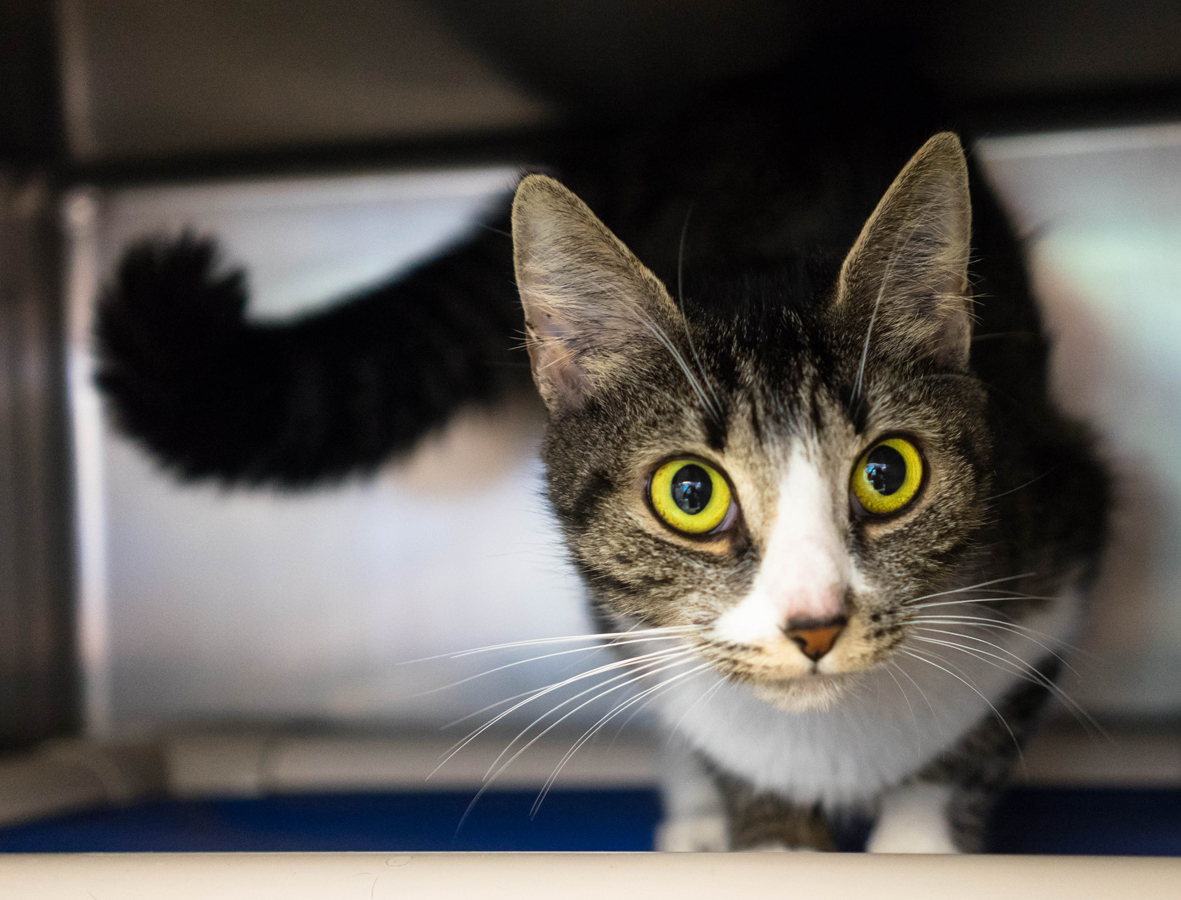
How about her? Spooky, excited, maybe a little risky. She’s not so sure about this situation. Dilated pupils, turned back whiskers, head is forward ehile body weight is backward and her tail is piloerect. She’s sending a lot of information, and trying to get a lot. She’s likely friendly but if you don’t go slow it could go either way. This is a cat I’d expect might be overstimulated pretty quickly!
The Whole Cat:
- 1. A cat whose weight is centered is typically comfortable, relaxed. A cat who is leaning forward...depends. If they seem relaxed or playful by other standards (eyes, ears, tail) they’re relaxed, playful, friendly. Otherwise, they might be offensively aggressive and ready to strike! A cat who is leaning backward is unsure, uncomfortable, or defensive – they may reel back before going for a lunge! You don’t ever want a cat to be leaning back, to be honest! That’s just low confidence!
- 2. A cat that is confident or offensive will try to make itself look larger, standing up tall, it might be piloerect, all of its features will expand. (Think of the Halloween cat pose!)
- 3. A cat that is fearful or defensive will try to make itself look smaller, crouching down low, tucking itself in, all of its features will contract. I think you saw plenty of terrified kiddos in our last post!
- 4. Piloerection isn’t just for the tail, it can happen on the entire body- as said before, this is just a reaction to stimulation, so it can happen for a variety of reasons. You might see it in aggression, fear, or play specifically, though!
- 5. A cat may provide its stomach as a sign of affection or submission, but that’s not necessarily an invitation to touch! Cats stomachs are very sensitive, and that's where all of their vital organs are! This is an ultimate sign of trust, respect it! if you know the cat likes belly rubs, go on ahead…but if not, tread with caution!
- 6. A cat who presents its butt is friendly and trusting. Be grateful! Sniffing butts is how they greet each other in the cat world, and instead of making you pursue them they’re openly saying “Here I am, I trust you!” It may seem weird to you, but it’s really cool on their end.
- 7. The “elevator butt” is a happy reaction. They’re telling you they like what you’re doing!
- 8. Rolling onto side: fearful/submission, or happy/playful.
- 9. Biting can of course be play, a warning of annoyance or frustration - “Stop that", or aggression/anger. Take the whole cat into account, the ABC’s and the severity. (Just like swats, some cats have poor inhibition.)
- 10. Lip licking: Nauseous, nervous, fearful.
- 11. Overgrooming or cessation of grooming: pain, stress. Should be addressed. Grooming, in general – not an over or under, can actually be a displacement behavior used in times of mild stress/uncertainty, often seen in playfighting, or mild spats. If things get too hot or aren’t going in one’s favor, they may stop and consider fleeing the “fight” for a moment. Instead of fleeing or pursuing again, they stop and groom themselves. Odd, right? They use these behaviors to calm themselves. It’s kind of like stimming! These can become stereotypies in some instances as well, in which case they can become harmful. (Compulsive, repetitive, irrelevant behaviors unrelated to current stimuli repeated under stressful situations) In these situations a cat might groom to the point of developing open wounds. So, displacement = “Not sure, a little stressed. Let me cool off.” Stereotypy = Malfunction, obsessive compulsion. Stereotypy is: stressor = Do the thing, endlessly.
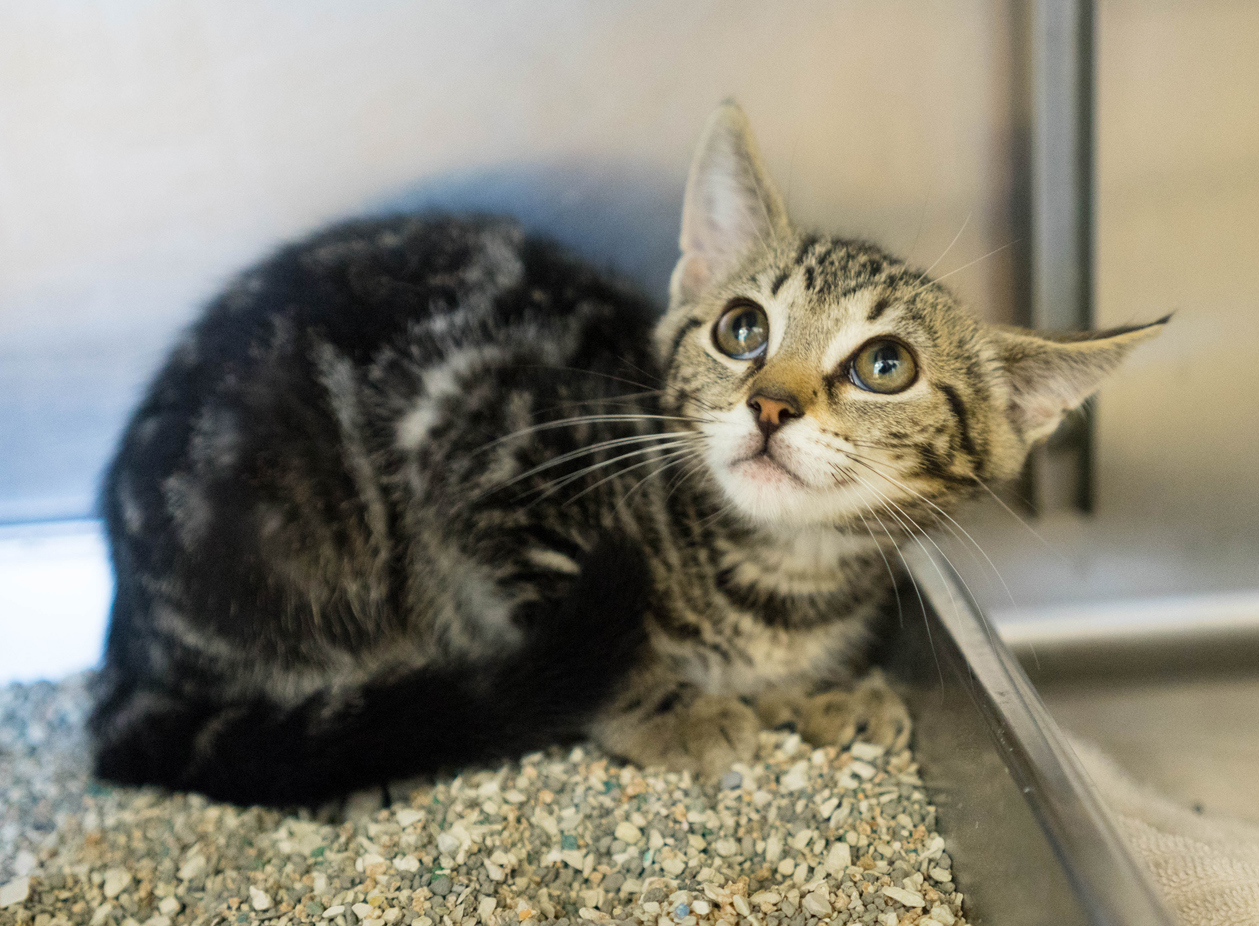
How about this spooked bean? Very scared! Whiskers are bulled back, ears starting to turn backwards, eyes whaling and beginning to dilate, body incredibly small, tail wrapped. This kitten would likely start rolling on it's back in fear if I placed my hand further in the kennel, ears going further into an airplane or into offensive positioning, leading to me getting bitten or swat at, or he’d try to bolt.
Whew! That was a lot! I’m sure there’s so much more we could cover, too! To save space, I included little tests in the photo captions; fun, right? I had hoped I had more examples of "extreme" emotions, but I guess I don’t take photos of extremely stressed cats very often, which I guess is a good thing...just not great for demonstrative purposes! Anyway, I hope this was helpful, or at least interesting. With that, I'll leave you to get ready for our next post!
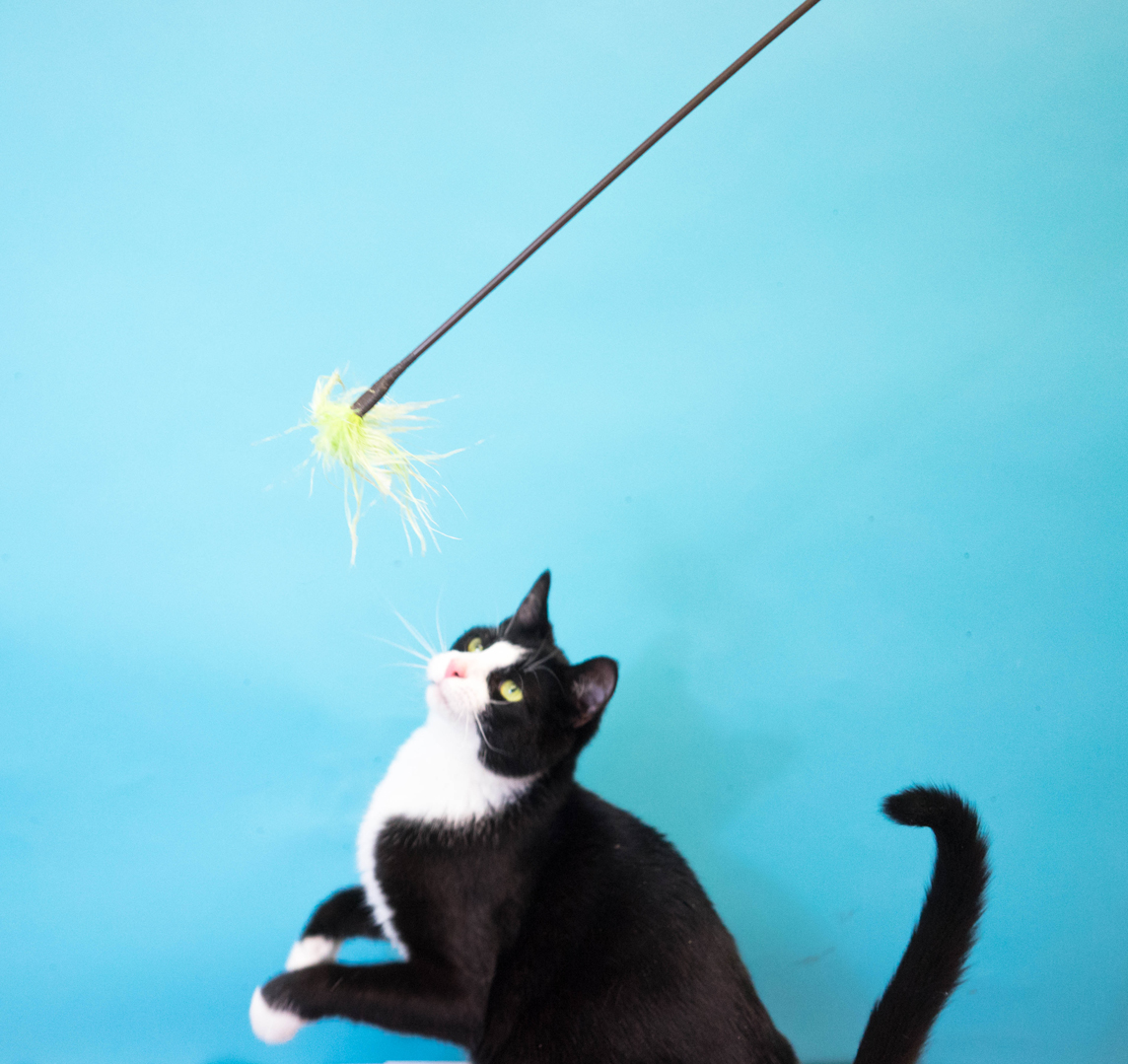
Ready like this guy was to pounce!
Until next time.
-Meg
